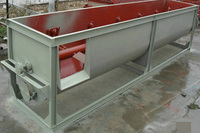Dewatering and Drying System
Product Quick Detail
- FOB Price
- USD $7,800.00 / Piece
- Minimum Order
- 1
- Place Of Origin
- china
- Packaging
- N/A
- Delivery
- 30-60days
Specifications
The section of dewatering and drying has come to final steps of cassava processing, the vacuum dehydrator can remove as much moisture as possible and the flash dryer can dry the wet starch to the
low moisture content of no more than 13% to achieve the starch storage standard. The hydraulic press can remove as much moisture as possible and the cassava Garri fryer can roast the wet Garri to
the low moisture content of no more than 13% to achieve the Garri storage standard.
Garri Fryer(Cassava Garri Fryer)
Dewatering and Drying System - Garri Fryer Machine
Processing Capacity: 100-300kgs/hour
Application Scope: Garri frying or roasting
Product Introduction: Garri fryer, cassava fryer machine, cassava fryin...
Airflow Flash Dryer(Cassava Drying Machine)
Dewatering and Drying System - Airflow Flash Dryer
Processing Capacity: 100-2000Kgs/hour
Application Scope: Cassava starch and flour drying
Product Introduction: Airflow flash dryer, cassava starch dryin...
Centrifugal Cassava Dewatering Machine
Dewatering and Drying System - Centrifugal Dewatering Machine
Processing Capacity: 1-10Tons/hour
Application Scope: Cassava or potato starch dewateringProduct Introduction: Centrifugal dewatering machin...
Hydraulic Dewatering Press
Dewatering and Drying System - Hydraulic Dewatering Press
Processing Capacity: 100-500kgs/hour
Application Scope: Cassava slurry dewatering
Product Introduction: Hydraulic dewatering press, hydraulic pre...
Rotary Vacuum Filter
Dewatering and Drying System - Rotary Vacuum FilterProcessing Capacity: 0.2-0.3Tons/h/m2Application Scope: Cassava or potato starch dewateringProduct Introduction: Rotary vacuum filter, rotary
vacuum ...Rotary Vacuum Filter
1. Vacuum filter: Drum filters or vacuum filters have been used for dewatering various slurries including starch slurry in the starch processing system. As the drum rotates, it is partially
submerged in the feed starch slurry. The vacuum draws liquid through the filter medium (cloth) on the drum surface which retains the solids. The vacuum pulls air through the cake and continues to
remove moisture as the drum rotates. If required, the cake can be washed to remove impurities or to extract more product.
Finally, the cake is discharged from the drum to a conveyor or chute to the next process step. The filtrate and air pulled through the medium flow through internal filtrate pipes and pass through
the rotary valve and into the filtrate receiver. The liquid stream is separated from the vapor stream in the receiver. The liquid filtrate is then pumped to the next step in the process.
The vacuum filter is widely used for the dehydration in starch, modified starch, medicine, food, chemical industry etc, low energy consumption, small area, friendly operation, and stable running.
2. Hydraulic press: Load the bags directly on to a hydraulic press. Under control of the hydraulic station and electric cabinet to lift and press the jack handle up and down until it becomes hard
to move. Repeat the process several times each day until no more water comes out of the bag to produce a firm wet cake.
3. Flash dryer: Flash drying is defined as the drying of particles that are suspended and conveyed in a hot air stream. Drying starch using a flash dryer is the most economical drying method. The
whole process is fully automatic requiring no handling or human involvement. The feed rate is adjusted automatically as per the variation in moisture content in wet cake thereby achieving
consistent product quality.
The principle of Flash Drying is to evaporate surface moisture instantaneously. It is well-known fact that the surface area of wet lump increases as the size of lump decreases. The wet cake is
disintegrated into fines to increase the surface area.
4. Garri fryer: Roasting be done mechanically using an automated Garri fryer made of stainless steel material and with electricity, natural gas, firewood or charcoal as the heat source. The
finished product (Garri) is usually recognized from the color change from white to cream (for non-palm oil fortified Garri) and crispy hand feel of the grains/particles.
- Country: China (Mainland)
- Address: Erlangmiao Street, FangCheng County, NanYang City, HeNan Province, China
- Contact: goodway china











